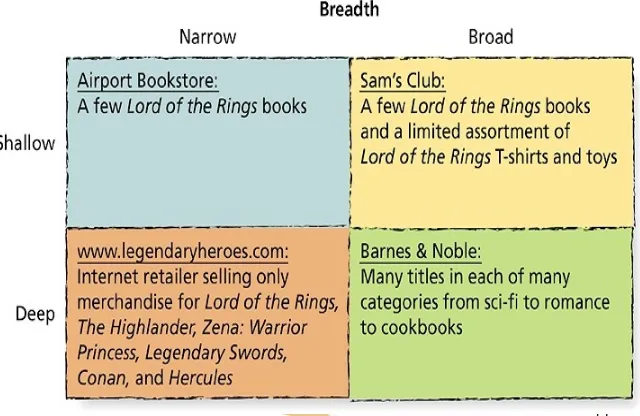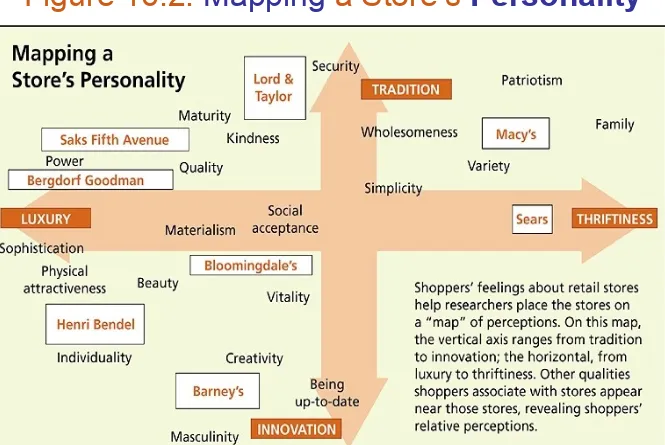Chapter Objectives
• Define retailing
Chapter Objectives
• B2C e-commerce
its benefits, limitations, and future
promise
• store image
positioning strategy
creating a desirable image in the
Retailing: Special Delivery
• Retailing:
• the process by
which goods and
Retailing: Special Delivery
• The retailer adds/subtracts value from the offering
• with its image, • inventory,
• service quality, • location, and
• pricing policy.
Retailing: A Mixed (Shopping) Bag
• Retailing is big business:
Retailing: A Mixed (Shopping) Bag
• Retailers
= final channel of distribution,
• providing
utilities
to customers
time,
place, and ownership.
The Evolution of Retailing
• The wheel-of-retailing hypothesis New types of retailers
• enter the market
• by offering lower-priced goods.
They gradually improve
• facilities, quality and
• assortment of merchandise, and amenities
The Evolution of Retailing (cont’d)
• The retail life cycle
Retailers are born, grow and mature, and eventually die or become obsolete.
Introduction stage
The Evolution Continues:
What’s “In Store” for the Future?
• Demographics:
• retailers must find new ways to sell to diverse groups.
The Evolution Continues: What’s “In Store” for the Future? (cont’d)
• Technology
Internet and e-tailing
Electronic point-of-sale (POS) systems
Cart-top computer
• to scan purchases as customers move through store
RFID tags
The Evolution Continues: What’s “In Store” for the Future? (cont’d)
• Globalization
Need to adjust to different conditions
• around the world
Innovative retailing concepts
• developing overseas
Classifying Retail Stores
• what they sell:
merchandise mix
• level of service
Self-service Full-service
Limited service
Classifying Retail Stores (cont’d)
• Classifying by merchandise selection
Merchandise assortment:
• selection of products a retailer sells
Merchandise breadth:
• number of different product lines
Merchandise depth:
Classifying Retail Stores (cont’d)
• Retail Format
Convenience stores Supermarkets
Specialty stores Discount stores
Warehouse clubs
Factory outlet stores
Non-store Retailing
• Any method a firm uses • to complete an exchange
• that does not require
• a customer to visit a store
Nonstore Retailing (cont’d)
• Direct selling
Door-to-door sales
Party plan system
Multilevel network:
• a master distributor recruits other people to become distributors
Illegal pyramid schemes:
• people pay money to advance in company, profiting from others who might join
B2C E-commerce
• (B2C) e-commerce: • online exchange
B2C E-commerce
• Benefits of B2C e-commerce
Facilitates global marketplace exchanges Increases consumer convenience
fulfills experiential needs. For specialized businesses. price information available.
B2C E-commerce (cont’d)
• Limitations of B2C e-commerce Customers must wait
• to receive products.
poorly designed Sites.
Security concerns.
Internet fraud
B2C E-commerce (cont’d)
• More Limitations
• Firms need “bricks-and-mortar” presence
to maintain base of loyal customers.
• Developing countries with cash economies
B2C E-commerce (cont’d)
• One More Limitation
• Online inventory • may cannibalize
• major retailer store sales.
B2C’s Effect on the Future of Retailing
• Virtual channels
unlikely to replace traditional ones.
• Stores must evolve
B2C’s Effect on the Future of Retailing
• In destination retail,
• consumers will visit stores • for total entertainment
experience.
• MOA & amusement park
Retailing as Theater
• Store image:
• the way a retailer • is perceived
• in the marketplace
Retailing as Theater
• Store image:
• Atmospherics: the use of:
• color, lighting,
• scents, furnishings,
• sounds, other design elements
Store Image (cont’d)
• Store design: setting the stage
Store layout:
• arrangement of merchandise in store – determines traffic flow
– (grid layout vs. free-flow layout)
Fixture type
merchandise density sound of music
Color & lighting
Store Image (cont’d)
• Store personnel:
should complement a store’s image
• Pricing policy
Price points/ranges
Retailing as Theater (cont’d)
• Store
location
Types of store locations
• Business districts
• Shopping centers
• Freestanding retailers
Retailing as Theater (cont’d)
• Store location (
Site selection
)
• Store’s trade area:
– geographic zone that accounts for the majority of its sales and customers
–Primary – Secondary - Tertiary
• Saturated trade area
TOP RETAILERS
• www.stores.org
• Top 100 retailers (U.S) • Top 200 global retailers
• Retailer of the year • NRF conference
Non-traditional retailing
• Tourism retailing
Souvenir shops
• Museums, events, resorts
Shopping trips
• MOA, Dallas, New York City
• Secondary retailing
Garage sales
The end
Real People, Real Choices
• Eskimo Joe’s (Stan Clark)
• A new Oklahoma law raised the legal drinking age from 18 to 21.
• How to ensure that Eskimo Joe’s would survive the new law?
Option 1: convert the beer bar into a full-service restaurant. Option 2: continue operating as a beer
bar and offset declining beer sales with an increase in apparel sales. Option 3: close Eskimo Joe’s bar
Real People, Real Choices
• Eskimo Joe’s (Stan Clark)
• Stan chose option 1: convert the beer bar to a full- service restaurant focused on selling great food.
The success was immediate, and Stan credits the result with paying close attention to the quality of food and service.
Discussion
• The wheel-of-retailing theory suggests the
retailer’s normal path is to enter the
marketplace with lower-priced goods and then increase quality, services, and prices.
--Why do you think this happens?
--Is it the right path for all retailers?
Discussion
• Wal-Mart has become a dominant retailer in the U.S. marketplace, accounting for over 30
percent of the total sales of some products.
--Is this good for consumers?
Discussion
• Department stores may be
declining in popularity in the United States but remain
the primary place to shop in other countries such as
Japan.
--Why do you think this is so?
Group Activity
• You and two friends decide to open a
combination coffee shop and bookstore near your college. To attract college students and other customers, you’ll need to carefully
design the store image. --Develop a detailed plan that specifies how your group
will use atmospherics
Discussion
• Experts predict a rosy future for B2C
e-commerce, with exponential increases in Internet sales of some product categories within a few years.
--What effect do you think the growth of e-retailing will have on traditional retailing?
Discussion
• Pyramid scheme promoters recruit at
frenzied meetings that make potential members fearful of passing up a great opportunity if they don’t join.
--Why do people continue to be lured into these schemes?
Discussion
• Macy’s and other stores use vending machines to sell electronics such as iPods.
List other opportunities for vending machine sales.
Group Activity
• Your team are business consultants for a chain of 37 traditional department stores in 12
Midwestern U.S. cities.
• The stores’ revenues have declined as specialty
stores and hypermarkets have begun to
squeeze them out. The chain has asked your group for suggestions to increase its business
Group Activity
• Your client is a local caterer planning to open a new retail outlet selling take-out gourmet
dinners.
• Your group of marketing consultants is examining locations: the central business
district, a shopping center, a freestanding entity, or a nontraditional location.
--Outline the advantages and disadvantages of each
Marketing Plan Exercise
• Think about a new retail venture, a
specialty store that sells timepieces such as men’s and ladies’ watches and clocks.
--What retailing strategies do you recommend for the first two years of the business—what merchandise, what store image, and what location(s)?
Marketing in Action Case: You Make the Call
• What is the decision facing IKEA? • What factors are important in
understanding this decision situation? • What are the alternatives?
• What decision(s) do you recommend? • What are some ways to implement your

